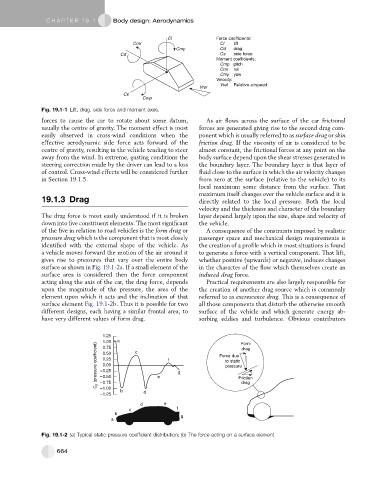Page 654 - Automotive Engineering Powertrain Chassis System and Vehicle Body
P. 654
CHAP TER 1 9. 1 Body design: Aerodynamics
Cl Force coefficients:
Cmr Cl lift
Cmy Cd drag
Cd Cs side force
Moment coefficients:
Cmp pitch
Cmr roll
Cmy yaw
Velocity:
Vrel Relative airspeed
Vrel
Cs
Cmp
Fig. 19.1-1 Lift, drag, side force and moment axes.
forces to cause the car to rotate about some datum, As air flows across the surface of the car frictional
usually the centre of gravity. The moment effect is most forces are generated giving rise to the second drag com-
easily observed in cross-wind conditions when the ponent which is usually referred to as surface drag or skin
effective aerodynamic side force acts forward of the friction drag. If the viscosity of air is considered to be
centre of gravity, resulting in the vehicle tending to steer almost constant, the frictional forces at any point on the
away from the wind. In extreme, gusting conditions the body surface depend upon the shear stresses generated in
steering correction made by the driver can lead to a loss the boundary layer. The boundary layer is that layer of
of control. Cross-wind effects will be considered further fluid close to the surface in which the air velocity changes
in Section 19.1.5. from zero at the surface (relative to the vehicle) to its
local maximum some distance from the surface. That
maximum itself changes over the vehicle surface and it is
19.1.3 Drag directly related to the local pressure. Both the local
velocity and the thickness and character of the boundary
The drag force is most easily understood if it is broken layer depend largely upon the size, shape and velocity of
down into five constituent elements. The most significant the vehicle.
of the five in relation to road vehicles is the form drag or A consequence of the constraints imposed by realistic
pressure drag which is the component that is most closely passenger space and mechanical design requirements is
identified with the external shape of the vehicle. As the creation of a profile which in most situations is found
a vehicle moves forward the motion of the air around it to generate a force with a vertical component. That lift,
gives rise to pressures that vary over the entire body whether positive (upwards) or negative, induces changes
surface as shown in Fig. 19.1-2a. If a small element of the in the character of the flow which themselves create an
surface area is considered then the force component induced drag force.
acting along the axis of the car, the drag force, depends Practical requirements are also largely responsible for
upon the magnitude of the pressure, the area of the the creation of another drag source which is commonly
element upon which it acts and the inclination of that referred to as excrescence drag. This is a consequence of
surface element Fig. 19.1-2b. Thus it is possible for two all those components that disturb the otherwise smooth
different designs, each having a similar frontal area, to surface of the vehicle and which generate energy ab-
have very different values of form drag. sorbing eddies and turbulence. Obvious contributors
1.25
1.00 a c Form
C p (pressure coefficient) –0.25 e f g Force due Friction
0.75
drag
0.50
0.25
to static
0.00
pressure
–0.50
–0.75
–1.00
b d drag
–1.25
d e
c f
b
g
a
Fig. 19.1-2 (a) Typical static pressure coefficient distribution; (b) The force acting on a surface element.
664

